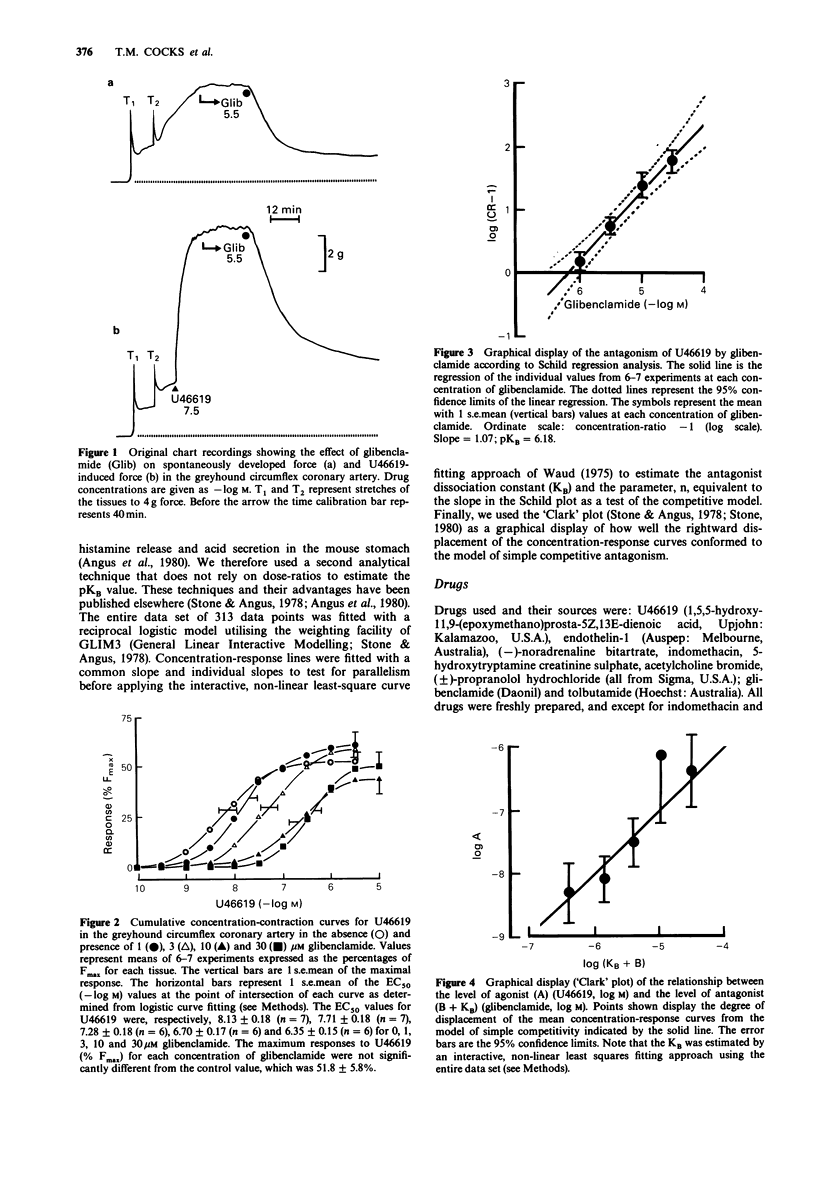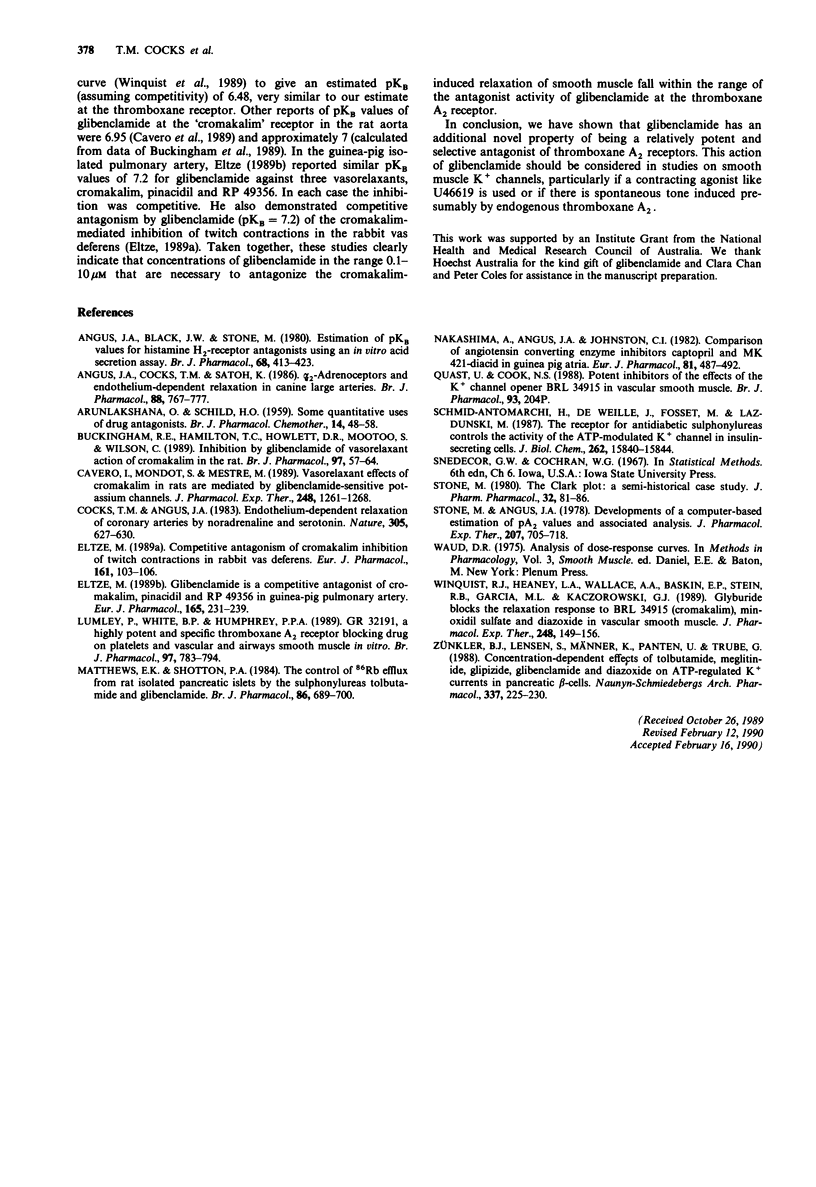Abstract
1. Glibenclamide, a sulphonylurea oral hypoglycaemic agent is a widely used antagonist of cromakalim-activated K+ channels in smooth muscle. 2. In isolated ring segments of the large circumflex coronary artery from the dog, glibenclamide (1-30 microM) caused a concentration-dependent reduction in both spontaneous isometric force and contractions induced by U46619, a thromboxane A2-mimetic. 3. Glibenclamide behaved as a competitive antagonist of U46619 with an estimated pKB (-log KB) value of 6.2 by Schild regression analysis (slope 1.07). 4. Glibenclamide (30 microM) was apparently selective since it had no effect on the concentration-contraction curves to endothelin-1, noradrenaline or KCl. 5. We suggest that this additional property of glibenclamide should be considered in any smooth muscle study where active force is raised by either the exogenous application or endogenous generation of thromboxane A2.
Full text
PDF



Selected References
These references are in PubMed. This may not be the complete list of references from this article.
- ARUNLAKSHANA O., SCHILD H. O. Some quantitative uses of drug antagonists. Br J Pharmacol Chemother. 1959 Mar;14(1):48–58. doi: 10.1111/j.1476-5381.1959.tb00928.x. [DOI] [PMC free article] [PubMed] [Google Scholar]
- Angus J. A., Black J. W., Stone M. Estimation of pKB values for histamine H2-receptor antagonists using an in vitro acid secretion assay. Br J Pharmacol. 1980 Mar;68(3):413–423. doi: 10.1111/j.1476-5381.1980.tb14555.x. [DOI] [PMC free article] [PubMed] [Google Scholar]
- Angus J. A., Cocks T. M., Satoh K. Alpha 2-adrenoceptors and endothelium-dependent relaxation in canine large arteries. Br J Pharmacol. 1986 Aug;88(4):767–777. doi: 10.1111/j.1476-5381.1986.tb16249.x. [DOI] [PMC free article] [PubMed] [Google Scholar]
- Buckingham R. E., Hamilton T. C., Howlett D. R., Mootoo S., Wilson C. Inhibition by glibenclamide of the vasorelaxant action of cromakalim in the rat. Br J Pharmacol. 1989 May;97(1):57–64. doi: 10.1111/j.1476-5381.1989.tb11923.x. [DOI] [PMC free article] [PubMed] [Google Scholar]
- Cavero I., Mondot S., Mestre M. Vasorelaxant effects of cromakalim in rats are mediated by glibenclamide-sensitive potassium channels. J Pharmacol Exp Ther. 1989 Mar;248(3):1261–1268. [PubMed] [Google Scholar]
- Cocks T. M., Angus J. A. Endothelium-dependent relaxation of coronary arteries by noradrenaline and serotonin. Nature. 1983 Oct 13;305(5935):627–630. doi: 10.1038/305627a0. [DOI] [PubMed] [Google Scholar]
- Eltze M. Competitive antagonism by glibenclamide of cromakalim inhibition of twitch contractions in rabbit vas deferens. Eur J Pharmacol. 1989 Feb 14;161(1):103–106. doi: 10.1016/0014-2999(89)90187-8. [DOI] [PubMed] [Google Scholar]
- Eltze M. Glibenclamide is a competitive antagonist of cromakalim, pinacidil and RP 49356 in guinea-pig pulmonary artery. Eur J Pharmacol. 1989 Jun 20;165(2-3):231–239. doi: 10.1016/0014-2999(89)90717-6. [DOI] [PubMed] [Google Scholar]
- Lumley P., White B. P., Humphrey P. P. GR32191, a highly potent and specific thromboxane A2 receptor blocking drug on platelets and vascular and airways smooth muscle in vitro. Br J Pharmacol. 1989 Jul;97(3):783–794. doi: 10.1111/j.1476-5381.1989.tb12017.x. [DOI] [PMC free article] [PubMed] [Google Scholar]
- Matthews E. K., Shotton P. A. The control of 86Rb efflux from rat isolated pancreatic islets by the sulphonylureas tolbutamide and glibenclamide. Br J Pharmacol. 1984 Jul;82(3):689–700. doi: 10.1111/j.1476-5381.1984.tb10808.x. [DOI] [PMC free article] [PubMed] [Google Scholar]
- Nakashima A., Angus J. A., Johnston C. I. Comparison of angiotensin converting enzyme inhibitors captopril and MK421-diacid in guinea pig atria. Eur J Pharmacol. 1982 Jul 16;81(3):487–492. doi: 10.1016/0014-2999(82)90114-5. [DOI] [PubMed] [Google Scholar]
- Schmid-Antomarchi H., De Weille J., Fosset M., Lazdunski M. The receptor for antidiabetic sulfonylureas controls the activity of the ATP-modulated K+ channel in insulin-secreting cells. J Biol Chem. 1987 Nov 25;262(33):15840–15844. [PubMed] [Google Scholar]
- Stone M., Angus J. A. Developments of computer-based estimation of pA2 values and associated analysis. J Pharmacol Exp Ther. 1978 Dec;207(3):705–718. [PubMed] [Google Scholar]
- Stone M. The Clark plot: a semi-historical case study. J Pharm Pharmacol. 1980 Feb;32(2):81–86. doi: 10.1111/j.2042-7158.1980.tb12857.x. [DOI] [PubMed] [Google Scholar]
- Winquist R. J., Heaney L. A., Wallace A. A., Baskin E. P., Stein R. B., Garcia M. L., Kaczorowski G. J. Glyburide blocks the relaxation response to BRL 34915 (cromakalim), minoxidil sulfate and diazoxide in vascular smooth muscle. J Pharmacol Exp Ther. 1989 Jan;248(1):149–156. [PubMed] [Google Scholar]
- Zünkler B. J., Lenzen S., Männer K., Panten U., Trube G. Concentration-dependent effects of tolbutamide, meglitinide, glipizide, glibenclamide and diazoxide on ATP-regulated K+ currents in pancreatic B-cells. Naunyn Schmiedebergs Arch Pharmacol. 1988 Feb;337(2):225–230. doi: 10.1007/BF00169252. [DOI] [PubMed] [Google Scholar]


